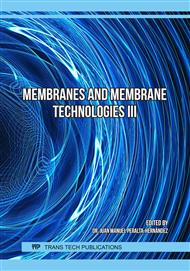[1]
S. Mansoori, R. Davarnejad, T. Matsuura, & A.F. Ismail in: Membranes based on non-synthetic (natural) polymers for waste treatment, Polymer Testing (2020, February 3).
DOI: 10.1016/j.polymertesting.2020.106381
Google Scholar
[2]
Water Safety and Quality, World Health Organization, (2019, September 25) www.who.int./water/_sanitation_health/water-quality/en/.
Google Scholar
[3]
Water Treatment, Water Sanitation, Water sanitation, World Health Organization, page 71, https://www.who.int/water _sanitation_health/hygiene/omlinkingchap6.pdf.
DOI: 10.2471/blt.21.287137
Google Scholar
[4]
M. Mulder in: Basic Principles of Membrane Technology, Kluwer Academic Publishers, London (1996).
Google Scholar
[5]
R. Mallada & M. Menedez in: Inorganic Membranes Membranes, Synthesis, Characterization and Applications, Elsevier: Amsterdam, The Netherlands (2008).
Google Scholar
[6]
Y. Nishio in: Material functionalization of cellulose and related polysaccharides via diverse microcompositions, Advances in Polymer Science, vol. 205, no. 1, pp.97-151 (2006).
DOI: 10.1007/12_095
Google Scholar
[7]
Membrane Filtration, Minnesota Water Works Operations Manual, Chapter 19 (2009).
Google Scholar
[8]
S.W. Kim, S.O. Han, I.N. Sim, J.Y. Cheon & W.H. Park in: Fabrication and Characterization of Cellulose Acetate/Montmorillonite Composite Nanofibers by Electrispinning, Journal of Nanomaterials (2015). http://dx.doi.org/10.1155/2015/275230.
DOI: 10.1155/2015/275230
Google Scholar
[9]
N. Ghaemi, S.S. Madaeni, A. Alizadeh, & H.Rajabi in: Preparation, characterization and performance of polyether sulfone/organically modified montmorillonite nanocomposite membranes in removal of pesticides, Journal of Membrane Science 382, pp.135-147 (2011).
DOI: 10.1016/j.memsci.2011.08.004
Google Scholar
[10]
N. Ghaemi, S.S. Madaeni, A. Alizadeh, & P. Daraei in: Fabrication of cellulose acetate/sodium dodecyl sulfate nanofiltration membrane: characterization and performance in rejection of pesticides, Desalination 290, pp.99-106 (2011).
DOI: 10.1016/j.desal.2012.01.013
Google Scholar
[11]
Goosen, A. Van Haute in: The Influence of Mineral Fillers on the Membrane Properties of High Flux Asymmetric Cellulose Acetate Reverse Osmosis Membranes, Desalination, 18, pp.203-214 (1976).
DOI: 10.1016/s0011-9164(00)84102-8
Google Scholar
[12]
Y. Wang, L. Yang, G. Luo, Y. Dai, Preparation of cellulose acetate membrane filled with metal oxide particles for the pervaporation separation of methanol/methyl tert-butyl ether mixtures, Chemical Engineering Journal 146 pp.6-10 (2009).
DOI: 10.1016/j.cej.2008.05.009
Google Scholar
[13]
D.S. Tong, C.H. Zhou, Y. Lu, H.Y. Yu, G.F. Zhang, & W.H. Yu in: Adsorption of acid red G dye on octadecyl trimethylammonium montmorillonite, Applied Clay Science 50, pp.427-431.
DOI: 10.1016/j.clay.2010.08.018
Google Scholar
[14]
C.H. Zhou, D. Zhang, D. S. Tong, L.M. Wu, W.H. Yu, & S. Ismadji in: Paper-like composites of cellulose acetate-organo-montmorillonite for removal of hazardous anionic dye in water. Chemical Engineering Journal 209, pp.223-234 (2012).
DOI: 10.1016/j.cej.2012.07.107
Google Scholar
[15]
J.A. de Lima, C. A. Pinotti, M.I. Felisberti, & M.D.C. Goncalves in: Morphology and Mechanical Properties of Nanocomposites of Cellulose Acetate and Organic Montmorillonite Prepared with Different Plasticizers, Wiley Online Library (2011, December 6).
DOI: 10.1002/app.35517
Google Scholar
[16]
F.S. Dehkordi, M. Pakizeh, & M.N. Mahboub, Properties and ultrafiltration efficiency of cellulose acetate/organically modified Mt (CA/OMMt) nanocomposite membrane foor humic acid removal, Applied Clay Science (2014).
DOI: 10.1016/j.clay.2014.11.042
Google Scholar
[17]
J. Zhang, M. Song, X. Wang, J. Wu, Z. Yang, J. Cao, Y. Chen, & Q. Wei in: Preparation of cellulose acetate/organic montmorillonite composite porous ultrafine fiber membrane for enzyme immobilization, Journal of Applied Polymer Science (21016).
DOI: 10.1002/app.43818
Google Scholar
[18]
F. Udin, Montmorillonite: And Introduction to Properties and Utilization, Current Topics in the Utilization of Clay in Industrial and Medical Applications (2020, June 25),.
Google Scholar



